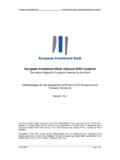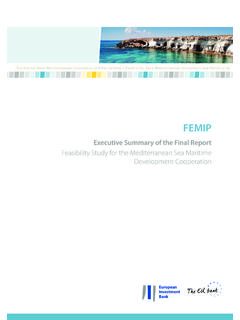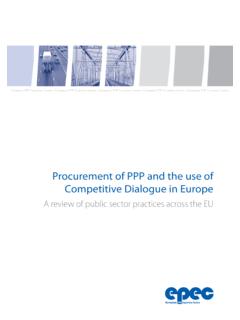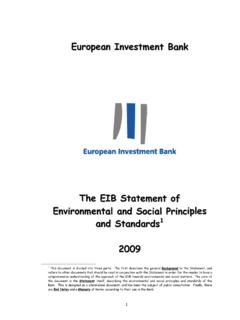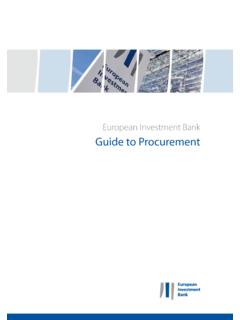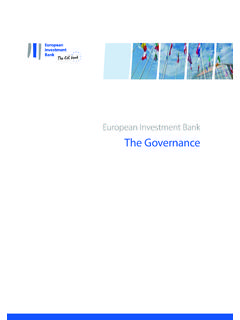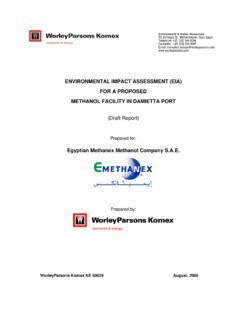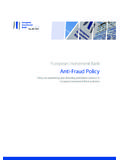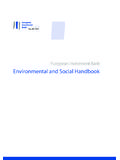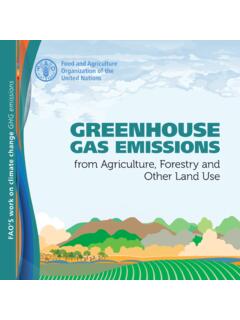Transcription of EIB Project Carbon Footprint Methodologies
1 European Investment Bank The Carbon Footprint of projects financed by the Bank 3 April 2014 page 1 / 53 European Investment Bank Induced GHG Footprint The Carbon Footprint of projects financed by the Bank Methodologies for the Assessment of Project GHG Emissions and Emission Variations Version The Pilot Carbon Footprint Exercise and GHG Methodologies were conceived by the Environment, Climate and Social Office (ECSO) in the Projects Directorate of the EIB, with the assistance of an external consultant (En-Vision Limited). The Task Manager was Andrea Pinna, assisted by Giulia Macagno. Completion of the Pilot, revision of the Methodologies and the mainstreaming of calculations into projects appraisals has now been finalised. The task manager was Nancy Saich, assisted by Oliver Johnson and members of the Carbon Footprint Task Force. European Investment Bank The Carbon Footprint of projects financed by the Bank 3 April 2014 page 2 / 53 CAVEAT The Methodologies contained in this document are designed primarily to guide EIB Project Directorate staff in the calculation of the Carbon Footprint of the projects financed by the Bank.
2 A number of caveats should be stressed from the outset. First, Carbon emissions result from virtually all human and natural activities. For example, even when the best available technologies are used when making cement, paper or steel, inevitably a significant quantity of CO2 is emitted. The Carbon Footprint measures GHG emissions. However, evaluating the merit of a Project requires comparing economic costs with benefits, including the costs and benefits in terms of incremental GHG emissions. Where appropriate, the Bank uses an economic (shadow price) of Carbon to convert changes in tonnes of GHG into euros. In short, whilst the Carbon Footprint is an important metric in its own right, it should be seen within the context of the overall economic appraisal of a Project . Second, the recommended Methodologies are by assumption restricted in scope. The Carbon Footprint does not purport to be a comprehensive life-cycle analysis of a Project . Such an exercise can only be done credibly ex-post and with a large amount of information.
3 The Carbon Footprint takes place ex-ante and with limited information and resources. For instance, downstream emissions from the use of the products and services resulting from EIB-financed projects are generally not considered. Examples are R&D projects in the area of efficient engines, a Project to build a PV panel or wind turbine factory, and a bio-ethanol refinery Project . In summary, in considering the scope and nature of the EIB pilot Carbon Footprint exercise, readers should be mindful that the Carbon Footprint of a Project per se cannot and should not be construed as an expression of the merit or value of that Project , either broadly or more narrowly in climate change terms alone. Additionally, for the sake of clarity it is important to bear in mind that the EIB Footprint exercise (as defined) is separate and distinct from another exercise also recently undertaken to formulate and estimate a climate change Key Performance Indicator (KPI) as part of the Corporate Operational Plan (COP) of the Bank.
4 The fact that a Project is, or is not, included in the Footprint assessment does not, at least in general terms, have any bearing on the classification of that same Project as a climate change Project for COP KPI purposes. Finally, Footprint work is relatively new. In the EIB it is considered work in progress that is subject to periodic review and revision in the light of experience gained and as knowledge of climate change issues evolves. ECSO welcomes comments and suggestions for improvement on the latest draft of the present document. Peter Carter Chief Environmentalist 3 August 2012 European Investment Bank The Carbon Footprint of projects financed by the Bank 3 April 2014 page 3 / 53 REVISION HISTORY Revision No. Issue Date Amendment Description Version 1 10 July 2009 First version issued following consultations on two draft editions. v2 10 Sept 2009 Revisions to incorporated changes following internal review v3 24 Sept 2009 Revisions to incorporated changes following launch of Methodologies v4 22 Oct 2009 Revisions following implementation of Methodologies v5 10 Nov 2009 Revisions to included amended baseline Methodologies v6 23 Nov 2009 Revisions following internal review v7 24 Feb 2010 Revisions following internal review v8 15 July 2010 Revision following internal review and comments 29 Sept 2010 Revision following internal review and comments Q1 2012 Holding version after preliminary review by the Carbon Footprint Task Force.
5 Issued before CSO Workshop V10 Q3 2012 Revision following feedback from PJ CFTF1, CSOs, MDB Working Group and the completion of the 3 year Pilot. Q1 2014 Table updated with 2014 figures 1 The Carbon Footprint Task Force adhoc group made up of a minimum of one PJ expert from each department tasked with reviewing sector Methodologies . European Investment Bank The Carbon Footprint of projects financed by the Bank 3 April 2014 page 4 / 53 Contents 1. OBJECTIVE .. 5 2. GUIDING PRINCIPLES .. 5 3. SIGNIFICANT EMISSIONS .. 6 4. Project BOUNDARIES (SEE FIGURE 1A/B) .. 9 5. METRICS .. 13 EMISSIONS FACTORS .. 13 ABSOLUTE EMISSIONS (AB): .. 13 BASELINE EMISSIONS (BE): .. 13 RELATIVE EMISSIONS (RE) .. 15 6. QUANTIFICATION PROCESS AND Methodologies .. 17 THE ASSESSMENT OF INTERMEDIATED PROJECTS .. 18 ANNEX 1: EMISSIONS CALCULATIONS BY Project .. 19 ANNEX 2: DEFAULT EMISSIONS CALCULATION Methodologies .
6 27 ANNEX 3: APPLICATION OF ELECTICITY GRID EMISSION FACTORS FOR Project BASELINES .. 50 GLOSSARY .. 53 European Investment Bank The Carbon Footprint of projects financed by the Bank 3 April 2014 page 5 / 53 1. Objective Most of the projects financed by the EIB emit greenhouse gases (GHG) into the atmosphere either directly ( fuel combustion or production process emissions) or indirectly through purchased electricity and/or heat. In addition, many projects result in emission reductions or increases when compared to what would have happened in the absence of the Project , referred to as baseline emissions. The Bank has carried out a 3-year pilot phase from 2009-2011 to measure the impact in GHG emissions from the projects it finances2. This document sets out the Methodologies to be applied going forward after the completion of the pilot. The Methodologies allow for the estimation of two measures of GHGs from projects financed by the Bank: the absolute GHG emissions of the Project , and; the variation in emissions compared to a baseline, referred to as the relative emissions, which can be either positive or negative.
7 The Methodologies set out below are based upon the internationally recognised IPCC Guidelines and the WRI GHG Protocol. In the absence of Project specific factors, the Methodologies adopt an IPCC factor applicable at the global or trans-national level (termed tier level 1 in IPCC). The development of the Methodologies has also been informed by ISO14064 parts 1 and 2 and the Voluntary Carbon Standard which provide guidelines for the development of greenhouse gas inventories at the corporate and Project levels. 2. Guiding principles Certain principles underpin the reporting of Project -based GHG absolute, baseline and relative emissions. These principles should guide users in cases where the proposed EIB Methodologies afford flexibility or discretion, or where a particular situation requires the application of a case specific factor. The application of these principles will help ensure the credibility and consistency of efforts to quantify and report emissions.
8 These principles are: Completeness All relevant information should be included in the quantification of a Project s GHG emissions and in the aggregation to the total EIB-induced GHG Footprint . This is to ensure that there are no material omissions from the data and information that would substantively influence the assessments and decisions of the users of the emissions data and information. Consistency The credible quantification of GHG emissions requires that methods and procedures are always applied to a Project and its components in the same manner, that the same criteria and assumptions are used to evaluate significance and relevance, and that any data collected and reported allow meaningful comparisons over time. Transparency Clear and sufficient information should be provided to allow for assessment of the credibility and reliability of reported GHG emissions. Specific exclusions or inclusions should be clearly identified and assumptions should be explained.
9 Appropriate references should be provided for both data and assumptions. Information relating to the Project boundary, the explanation of baseline choice, and the estimation of baseline emissions should be sufficient to replicate results and understand the conclusions drawn. 2 The EIB Carbon Footprint Exercise includes direct Investment Loans and large Framework Loan allocations that meet the significant emissions thresholds defined in section 3. Other intermediated lending is not currently included due to the limited information available to carry out a useful calculation for numerous sub-projects. European Investment Bank The Carbon Footprint of projects financed by the Bank 3 April 2014 page 6 / 53 Conservativeness EIB should use conservative assumptions, values, and procedures. Conservative values and assumptions are those that are more likely to overestimate absolute emissions and underestimate negative relative emissions.
10 balance balance means that the data set should reflect both the positive and negative aspects of the EIB GHG emissions performance to enable users to make a reasoned assessment of overall performance. Accuracy Uncertainties with respect to GHG measurements, estimates, or calculations should be reduced as far as is practical, and measurement and estimation methods should avoid bias. Where accuracy is sacrificed, data and estimates used to quantify GHG reductions (relative emissions) should be conservative. 3. Significant emissions Not all projects need to be included in the GHG Footprint and only projects with significant emissions are to be assessed. Based on the results of the first six months of the GHG Footprint pilot in 2009 it was decided to set minimum Project thresholds for inclusion in the GHG Footprint exercise as follows: Absolute emissions greater than 100, 000 tCO2-e Relative emissions (either positive or negative) greater than 20,000 tCO2-e The results revealed that these thresholds capture approximately 95% of the absolute and relative GHG emissions from projects and are in line with those set by other financial institutions for their GHG accounting.
